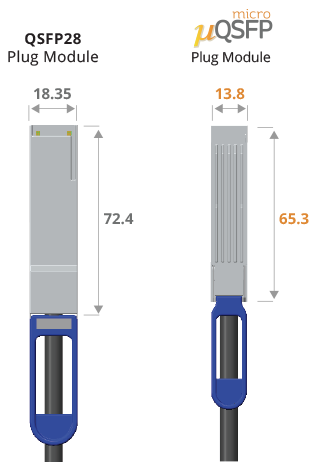As networking equipment becomes denser and port counts in the data center increase to hundreds and thousands of ports, managing cables connected to these devices become a difficult challenge. Traditionally, connecting cables directly to individual ports on low port-count equipment was considered manageable. Applying the same principles to high port-count equipment made the task more […]
Author: FOWIKI.com
What is SWDM4
SWDM4 is a new technology to support 100G over MMF (multimode fiber. Currently, there are only proprietary solutions without a MSA but this may change as commercialization continues. SWDM4 uses a complex shortwave wavelength division multiplex (SWDM) technology. Light at four different wavelengths (850, 880, 910 and 940 nm) are transmitted in a multi-mode fashion […]
Introduction to μQSFP Transceiver
The μQSFP transceiver is being presented as a potential future interface by the Ethernet Alliance. This is a very challenging technical concept for a 100GBASE-SR4 transceiver with MPO connector interface having the outer dimensions of the SFP+ form factor. μQSFP transceiver with MPO connector interface With the μQSFP form-factor it becomes possible to keep the […]
Inspect and Clean High Density MPO/MTP Connector
Before you install the MTP/MPO connectors in the data center, it is essential that all the fiber end-faces and the ferrule are really clean. especially when you thinking about lining up 12, 16, 24 or 32 pieces of 9um fibers in one or two rows, it requires tremendous precision. Any dirts in the mix on […]
TARLUZ 100G QSFP28 Transceivers
The QSFP28 (Quad Small Form Pluggable) transceiver form factor was established to enable multi-lane (quad) optical transceivers, such as 100GbE and 128GFC, with a variety of optical connectors (such as 4+4 MPO and duplex LC). TARLUZ 100G QSFP28 optical transceiver including SR4, CWDM4, LR4 series, complied with IEEE 802.3bm and SFF-8636, compatible with network device […]
What is QSFP-DD Modules
Backwards compatibility is the primary appeal of the QSFP-DD form factor. The QSFP form factor is today’s industry workhorse for delivering 40 and 100GbE. The “Q” is for “quad” — a nod to the four-channel electrical interface, with each lane running at 25 Gbps for 100GbE. QSFP-DD adapts the same basic concept as its predecessor, […]
Difference among Fujikura FSM-70+, Sumitomo TYPE-72C, Fitel S179A and INNO View 7 Fusion Splicer
The following is a comparison table among Fujikura FSM-70S+/FSM-80S+, Sumitomo Type-72C, Fitel S179A and INNO View 7 Fusion Splicers. Manufacturer FUJIKURA SUMITOMO FITEL INNO Model No. FSM-70S+ TYPE-72C S179A View 7 Splicing Method Core Alignment Core Alignment Core Alignment Core Alignment Applicable Fibers SM(G. 652/657) MM(G.651) DS(G. 653) NZDS(G. 655) SM(G. 652/657) MM(G.651) DS(G. 653) […]
Differences among Multimode (OM1, OM2, OM3, OM4, OM5) and Single Mode (OS1, OS2) Fiber
What are OM and OS type fiber optic cables? In ANSI/TIA-568.3-D, the TIA adopted the nomenclature for fiber found in the international standard ISO/IEC 11801. The multimode fiber is prefixed with “OM” and the singlemode mode “OS”. The new designation in ANSI/TIA-568.3-D should alleviate some of the confusion associated with application support distance issues. Each […]
Network classifications and categories
Classes Link / channel Cable / connectors Ethernet Speed Shielded / unshielded connector type Distance Class A 100 kHz Category 1 Class B 1 MHz Category 2 Class C 16 MHz Category 3 telephony & 10 mbps UTP RJ11/12/45 N.A. 25 MHz Category 5 10/100 mbps UTP/FTP RJ45 (2 pairs) 100m (90+10) Class D […]
Blowing Method for Air Blown Fiber
Cable installation by using high-speed air ow combined with additional mechanical pushing force is called as “blowing or jetting”. Cable blowing is the process of installation of optical ber cable into a pre-installed duct. Compressed air is injected into the duct inlet after few hundred meters of cable is pushed into the duct. Compressed air […]
